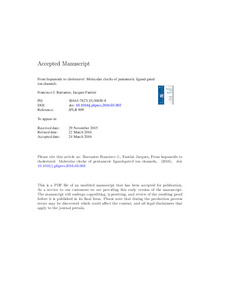Por favor, use este identificador para citar o enlazar este ítem:
https://repositorio.uca.edu.ar/handle/123456789/14049| Campo DC | Valor | Lengua/Idioma |
|---|---|---|
| dc.contributor.author | Barrantes, Francisco José | es |
| dc.contributor.author | Fantini, Jacques | es |
| dc.date.accessioned | 2022-05-30T12:53:52Z | - |
| dc.date.available | 2022-05-30T12:53:52Z | - |
| dc.date.issued | 2016 | - |
| dc.identifier.citation | Barrantes, F.J., Fantini, J. From hopanoids to cholesterol : molecular clocks of pentameric ligand-gated ion channels [en línea]. Progress in Lipid Research. 2016, 63 doi: 10.1016/j.plipres.2016.03.003 Disponible en: https://repositorio.uca.edu.ar/handle/123456789/14049 | es |
| dc.identifier.issn | 0163-7827 | - |
| dc.identifier.uri | https://repositorio.uca.edu.ar/handle/123456789/14049 | - |
| dc.description.abstract | Abstract: Pentameric ligand-gated ion channels (pLGICs) and their lipid microenvironments appear to have acquired mutually adaptive traits along evolution: 1) the three-ring architecture of their transmembrane (TM) region; 2) the ability of the outermost TM ring to convey lipid signals to the middle ring, which passes them on to the central pore ring, and 3) consensus motifs for sterol recognition in all pLGICs. Hopanoids are triterpenoid fossil lipids that constitute invaluable biomarkers for tracing evolution at the molecular scale. The cyanobacterium Gloeobacter violaceus is the oldest known living organism in which the X-ray structure of its pLGIC, GLIC, reveals the presence of the above attributes and, as discussed in this review, the ability to bind hopanoids. ELIC, the pLGIC from the bacillus Erwinia chrysanthemi is the only other known case to date. Both prokaryotes lack cholesterol but their pLGICs exhibit the same sterol motifs as mammalian pLGIC. This remarkable conservation suggests that the association of sterols and hopanoid surrogate molecules arose from the early need in prokaryotes to stabilize pLGIC TM regions by means of relatively rigid lipid molecules. The conservation of these phenotypic traits along such a long phylogenetic span leads us to suggest the possible co-evolution of these sterols with pLGICs. | es |
| dc.format | application/pdf | es |
| dc.language.iso | spa | es |
| dc.publisher | Elsevier | es |
| dc.rights | Acceso abierto | * |
| dc.rights.uri | http://creativecommons.org/licenses/by-nc-sa/4.0/ | * |
| dc.source | Progress in Lipid Research. 2016, 63 | es |
| dc.subject | COLESTEROL | es |
| dc.subject | CANALES IONICOS | es |
| dc.subject | HOPANOIDES | es |
| dc.subject | ESTEROIDES | es |
| dc.title | From hopanoids to cholesterol : molecular clocks of pentameric ligand-gated ion channels | es |
| dc.type | Artículo | es |
| dc.identifier.doi | 10.1016/j.plipres.2016.03.003 | - |
| dc.identifier.pmid | 27084463 | - |
| uca.disciplina | MEDICINA | es |
| uca.issnrd | 1 | es |
| uca.affiliation | Fil: Barrantes, Francisco José. Pontificia Universidad Católica Argentina. Facultad de Ciencias Médicas. Instituto de Investigaciones Biomédicas. Laboratorio de Neurobiología Molecular; Argentina | es |
| uca.affiliation | Fil: Barrantes, Francisco José. Consejo Nacional de Investigaciones Científicas y Técnicas; Argentina | es |
| uca.affiliation | Fil: Fantini, Jacques. Aix-Marseille Université. Interactions Moléculaires et Systèmes Membranaires; Francia | es |
| uca.version | acceptedVersion | es |
| item.languageiso639-1 | es | - |
| item.grantfulltext | open | - |
| item.fulltext | With Fulltext | - |
| crisitem.author.dept | Instituto de Investigaciones Biomédicas - BIOMED | - |
| crisitem.author.dept | Laboratorio de Neurobiología Molecular | - |
| crisitem.author.dept | Facultad de Ciencias Médicas | - |
| crisitem.author.orcid | 0000-0002-4745-681X | - |
| crisitem.author.parentorg | Facultad de Ciencias Médicas | - |
| crisitem.author.parentorg | Instituto de Investigaciones Biomédicas - BIOMED | - |
| crisitem.author.parentorg | Pontificia Universidad Católica Argentina | - |
| Aparece en las colecciones: | Artículos | |
Ficheros en este ítem:
| Fichero | Descripción | Tamaño | Formato | |
|---|---|---|---|---|
| from-hopanoids-to-cholesterol.pdf | 309,31 kB | Adobe PDF |  Visualizar/Abrir |
Visualizaciones de página(s)
42
comprobado en 27-abr-2024
Descarga(s)
93
comprobado en 27-abr-2024
Google ScholarTM
Ver en Google Scholar
Altmetric
Altmetric
Este ítem está sujeto a una Licencia Creative Commons

